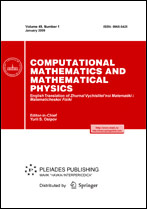|
This article is cited in 1 scientific paper (total in 1 paper)
Analysis of stability boundaries of satellite’s equilibrium attitude in a circular orbit
M. A. Novikov
Matrosov Institute for System Dynamics and Control Theory of Siberian Branch of Russian Academy of Sciences, Irkutsk
Abstract:
An asymmetric satellite equipped with control momentum gyroscopes (CMGs) with the center of mass of the system moving uniformly in a circular orbit was considered. The stability of a relative equilibrium attitude of the satellite was analyzed using Lyapunov’s direct method. The Lyapunov function <em class="EmphasisTypeItalic ">V</em> is a positive definite integral of the total energy of the perturbed motion of the system. The asymptotic stability analysis of the stationary motion of the conservative system was based on the Barbashin-Krasovskii theorem on the nonexistence of integer trajectories of the set <span class="InlineEquation" id="IEq1">\(\dot V\)</span>, which was obtained using the differential equations of motion of the satellite with CMGs. By analyzing the sign definiteness of the quadratic part of <em class="EmphasisTypeItalic ">V</em>, it was found earlier by V.V. Sazonov that the stability region is described by four strict inequalities. The asymptotic stability at the stability boundary was analyzed by sequentially turning these inequalities into equalities with terms of orders higher than the second taken into account in <em class="EmphasisTypeItalic ">V</em>. The sign definiteness analysis of the inhomogeneous function <em class="EmphasisTypeItalic ">V</em> at the stability boundary involved a huge amount of computations related to the multiplication, expansion, substitution, and factorization of symbolic expressions. The computations were performed by applying a computer algebra system on a personal computer.
Received: 21.04.2015
Revised: 28.08.2015
Citation:
M. A. Novikov, “Analysis of stability boundaries of satellite’s equilibrium attitude in a circular orbit”, Zh. Vychisl. Mat. Mat. Fiz., 56:3 (2016), 421–431; Comput. Math. Math. Phys., 56:3 (2016), 407–416
Linking options:
https://www.mathnet.ru/eng/zvmmf10350 https://www.mathnet.ru/eng/zvmmf/v56/i3/p421
|


| Statistics & downloads: |
| Abstract page: | 289 | | Full-text PDF : | 71 | | References: | 82 | | First page: | 10 |
|





 Contact us:
Contact us: Terms of Use
Terms of Use
 Registration to the website
Registration to the website Logotypes
Logotypes








 Citation in format
Citation in format 
